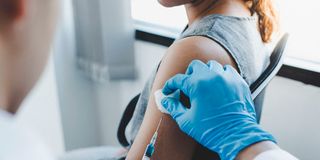Advancing women’s health through collaboration and innovation

Kenya’s national HPV vaccination programme has been a game-changer in cervical cancer prevention. By 2023, the Ministry of Health reported that over 1.3 million adolescent girls had received the vaccine, marking a critical step in reducing future cases of cervical cancer.
What you need to know:
- Conditions such as cervical and breast cancer remain leading causes of death despite being largely preventable and treatable when detected early.
- Likewise, maternal health complications that should be manageable continue to claim lives due to limited access, delayed intervention, and financial barriers.
Last month, the world marked International Women’s Day - a moment to reflect on achievements, celebrate milestones, and, most importantly, push for lasting change in the pursuit of gender equity.
In the healthcare sector, the 2025 theme, “Accelerating Access,” highlighted the critical need to remove systemic barriers that hinder women from receiving quality care. However, this theme must not be treated as a one-day conversation. It should serve as a catalyst for continuous, tangible action throughout the year. True change demands sustained efforts. Policies must be implemented, healthcare access must be expanded, and collaborative solutions must be prioritised to ensure that no woman is left behind.
Multiple barriers
Access to healthcare remains uneven in Kenya, with women encountering multiple barriers - from financial constraints and inadequate infrastructure to sociocultural norms that restrict their autonomy over health decisions. Despite these challenges, significant strides have been made in enhancing healthcare access and outcomes for women.
The path to equitable healthcare
Women’s healthcare has historically been reactive rather than proactive, leading to severe consequences. Conditions such as cervical and breast cancer remain leading causes of death despite being largely preventable and treatable when detected early. Likewise, maternal health complications that should be manageable continue to claim lives due to limited access, delayed intervention, and financial barriers.
However, progress is being made. Increasing access to mobile health services, community-based education, and subsidised screening has empowered more women to take control of their health. Digital innovations such as telemedicine consultations and AI-assisted diagnostics offer new opportunities, particularly in remote and underserved areas.
Kenya’s national HPV vaccination programme has been a game-changer in cervical cancer prevention. By 2023, the Ministry of Health reported that over 1.3 million adolescent girls had received the vaccine, marking a critical step in reducing future cases of cervical cancer.
The impetus for public-private collaboration
Women’s healthcare cannot advance through isolated interventions alone. Strengthening public-private partnerships is a crucial step in ensuring the strengths of both sectors complement each other. While public hospitals provide wide-reaching access, particularly in rural areas, private healthcare institutions offer advanced technology, specialised expertise and research-driven approaches.
Collaborative healthcare models can drive meaningful change through joint screening and vaccination initiatives, maternal health programmes, and integrated digital health solutions that enhance access to specialised care. These partnerships are also vital in bridging gaps in training and capacity-building, equipping healthcare professionals with the skills needed to deliver high-quality care.
Beyond service delivery, strategic investment must extend to policy advocacy and system-wide reforms. Healthcare institutions play a key role in shaping public health priorities, advocating for increased investment in gender-responsive policies, and championing inclusive health financing models that remove financial barriers for women seeking care.
Accelerating access is a collective responsibility
The 2025 International Women’s Day theme underscores that accelerating healthcare access for women is not just a moral imperative but a socioeconomic necessity. When women receive quality healthcare, families, communities and economies thrive. Reducing preventable diseases, ensuring safer maternal health experiences, and empowering women with health knowledge are not just healthcare priorities but fundamental to national development.
Both public and private healthcare institutions have a unique opportunity to lead this transformation - not only through service provision but also through thought leadership, innovation, and cross-sector collaboration. Real and lasting change can be achieved by working together, investing in preventive care and advocating for sustainable policies.
Kenya has already made significant progress in improving healthcare access for women, but more remains to be done. The launch of Kenya’s Breastfeeding Bill, for instance, has been a crucial step in supporting maternal and infant health by mandating workplace breastfeeding spaces. This initiative reduces stress for working mothers, enhances infant nutrition, boosts workplace productivity, and promotes gender equality. Higher breastfeeding rates also contribute to lower healthcare costs and improved public health, creating a more supportive environment for women to balance career and childcare.
To build on these achievements, strengthening partnerships and increasing investment in targeted health initiatives are essential to ensuring that no woman is left behind. The opportunity to transform women’s healthcare outcomes exists, what remains is the collective will to act.
Ms Muiyuro is the acting director of Nursing Services at the Nairobi Hospital




